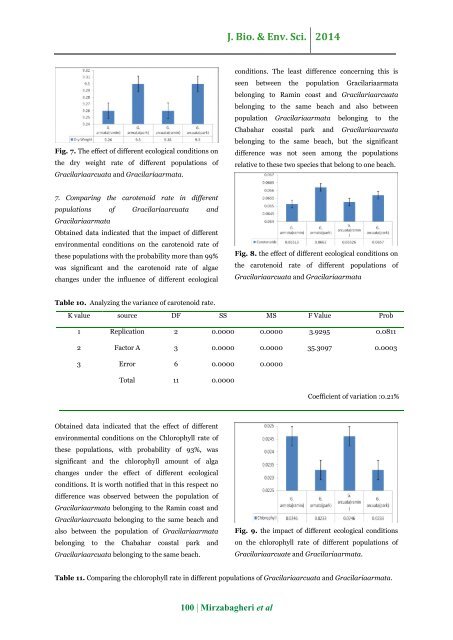Effects of various environmental conditions on morphology, genetics and some physiological factors of 8 population of red algae pertaining to Southern Coastlines of Iran
Abstract In this research which is performed during 2012 and 2013 , 8 population of red algae which were regarded as 8 suspected , and separated species were compared in 3 replications from the viewpoint of habitat , apparent form , DNA sequence in region of CholoroplasticrbcL, Protein amount , dry weight , chlorophyll and cartenoide amount . The derived data appointed these 8 populations pertaining to Gracilariacorticataand Gracilariaarcuataspecies, because of nondifference in DNA sequence and protein amount, despite they were influenced by environmental conditions and they indicated meaningful changes from the viewpoint of chlorophyll and cartenoide amounts and in some cases dry weight, as well as their morphology indicated some changes in various ecologic conditions.
Abstract
In this research which is performed during 2012 and 2013 , 8 population of red algae which were regarded as 8 suspected , and separated species were compared in 3 replications from the viewpoint of habitat , apparent form , DNA sequence in region of CholoroplasticrbcL, Protein amount , dry weight , chlorophyll and cartenoide amount . The derived data appointed these 8 populations pertaining to Gracilariacorticataand Gracilariaarcuataspecies, because of nondifference in DNA sequence and protein amount, despite they were influenced by environmental conditions and they indicated meaningful changes from the viewpoint of chlorophyll and cartenoide amounts and in some cases dry weight, as well as their morphology indicated some changes in various ecologic conditions.
You also want an ePaper? Increase the reach of your titles
YUMPU automatically turns print PDFs into web optimized ePapers that Google loves.
J. Bio. & Env. Sci. 2014<br />
Fig. 7. The effect <str<strong>on</strong>g>of</str<strong>on</strong>g> different ecological <str<strong>on</strong>g>c<strong>on</strong>diti<strong>on</strong>s</str<strong>on</strong>g> <strong>on</strong><br />
the dry weight rate <str<strong>on</strong>g>of</str<strong>on</strong>g> different populati<strong>on</strong>s <str<strong>on</strong>g>of</str<strong>on</strong>g><br />
Gracilariaarcuata <strong>and</strong> Gracilariaarmata.<br />
<str<strong>on</strong>g>c<strong>on</strong>diti<strong>on</strong>s</str<strong>on</strong>g>. The least difference c<strong>on</strong>cerning this is<br />
seen between the populati<strong>on</strong> Gracilariaarmata<br />
bel<strong>on</strong>ging <strong>to</strong> Ramin coast <strong>and</strong> Gracilariaarcuata<br />
bel<strong>on</strong>ging <strong>to</strong> the same beach <strong>and</strong> also between<br />
populati<strong>on</strong> Gracilariaarmata bel<strong>on</strong>ging <strong>to</strong> the<br />
Chabahar coastal park <strong>and</strong> Gracilariaarcuata<br />
bel<strong>on</strong>ging <strong>to</strong> the same beach, but the significant<br />
difference was not seen am<strong>on</strong>g the populati<strong>on</strong>s<br />
relative <strong>to</strong> these two species that bel<strong>on</strong>g <strong>to</strong> <strong>on</strong>e beach.<br />
7. Comparing the carotenoid rate in different<br />
populati<strong>on</strong>s <str<strong>on</strong>g>of</str<strong>on</strong>g> Gracilariaarcuata <strong>and</strong><br />
Gracilariaarmata<br />
Obtained data indicated that the impact <str<strong>on</strong>g>of</str<strong>on</strong>g> different<br />
<str<strong>on</strong>g>envir<strong>on</strong>mental</str<strong>on</strong>g> <str<strong>on</strong>g>c<strong>on</strong>diti<strong>on</strong>s</str<strong>on</strong>g> <strong>on</strong> the carotenoid rate <str<strong>on</strong>g>of</str<strong>on</strong>g><br />
these populati<strong>on</strong>s with the probability more than 99%<br />
was significant <strong>and</strong> the carotenoid rate <str<strong>on</strong>g>of</str<strong>on</strong>g> <strong>algae</strong><br />
changes under the influence <str<strong>on</strong>g>of</str<strong>on</strong>g> different ecological<br />
Fig. 8. the effect <str<strong>on</strong>g>of</str<strong>on</strong>g> different ecological <str<strong>on</strong>g>c<strong>on</strong>diti<strong>on</strong>s</str<strong>on</strong>g> <strong>on</strong><br />
the carotenoid rate <str<strong>on</strong>g>of</str<strong>on</strong>g> different populati<strong>on</strong>s <str<strong>on</strong>g>of</str<strong>on</strong>g><br />
Gracilariaarcuata <strong>and</strong> Gracilariaarmata<br />
Table 10. Analyzing the variance <str<strong>on</strong>g>of</str<strong>on</strong>g> carotenoid rate.<br />
K value<br />
source<br />
DF<br />
SS<br />
MS<br />
F Value<br />
Prob<br />
1<br />
Replicati<strong>on</strong><br />
2<br />
0.0000<br />
0.0000<br />
3.9295<br />
0.0811<br />
2<br />
Fac<strong>to</strong>r A<br />
3<br />
0.0000<br />
0.0000<br />
35.3097<br />
0.0003<br />
3<br />
Error<br />
6<br />
0.0000<br />
0.0000<br />
Total<br />
11<br />
0.0000<br />
Coefficient <str<strong>on</strong>g>of</str<strong>on</strong>g> variati<strong>on</strong> :0.21%<br />
Obtained data indicated that the effect <str<strong>on</strong>g>of</str<strong>on</strong>g> different<br />
<str<strong>on</strong>g>envir<strong>on</strong>mental</str<strong>on</strong>g> <str<strong>on</strong>g>c<strong>on</strong>diti<strong>on</strong>s</str<strong>on</strong>g> <strong>on</strong> the Chlorophyll rate <str<strong>on</strong>g>of</str<strong>on</strong>g><br />
these populati<strong>on</strong>s, with probability <str<strong>on</strong>g>of</str<strong>on</strong>g> 93%, was<br />
significant <strong>and</strong> the chlorophyll amount <str<strong>on</strong>g>of</str<strong>on</strong>g> alga<br />
changes under the effect <str<strong>on</strong>g>of</str<strong>on</strong>g> different ecological<br />
<str<strong>on</strong>g>c<strong>on</strong>diti<strong>on</strong>s</str<strong>on</strong>g>. It is worth notified that in this respect no<br />
difference was observed between the populati<strong>on</strong> <str<strong>on</strong>g>of</str<strong>on</strong>g><br />
Gracilariaarmata bel<strong>on</strong>ging <strong>to</strong> the Ramin coast <strong>and</strong><br />
Gracilariaarcuata bel<strong>on</strong>ging <strong>to</strong> the same beach <strong>and</strong><br />
also between the populati<strong>on</strong> <str<strong>on</strong>g>of</str<strong>on</strong>g> Gracilariaarmata<br />
bel<strong>on</strong>ging <strong>to</strong> the Chabahar coastal park <strong>and</strong><br />
Gracilariaarcuata bel<strong>on</strong>ging <strong>to</strong> the same beach.<br />
Fig. 9. the impact <str<strong>on</strong>g>of</str<strong>on</strong>g> different ecological <str<strong>on</strong>g>c<strong>on</strong>diti<strong>on</strong>s</str<strong>on</strong>g><br />
<strong>on</strong> the chlorophyll rate <str<strong>on</strong>g>of</str<strong>on</strong>g> different populati<strong>on</strong>s <str<strong>on</strong>g>of</str<strong>on</strong>g><br />
Gracilariaarcuate <strong>and</strong> Gracilariaarmata.<br />
Table 11. Comparing the chlorophyll rate in different populati<strong>on</strong>s <str<strong>on</strong>g>of</str<strong>on</strong>g> Gracilariaarcuata <strong>and</strong> Gracilariaarmata.<br />
100 | Mirzabagheri et al





![Review on: impact of seed rates and method of sowing on yield and yield related traits of Teff [Eragrostis teff (Zucc.) Trotter] | IJAAR @yumpu](https://documents.yumpu.com/000/066/025/853/c0a2f1eefa2ed71422e741fbc2b37a5fd6200cb1/6b7767675149533469736965546e4c6a4e57325054773d3d/4f6e6531383245617a537a49397878747846574858513d3d.jpg?AWSAccessKeyId=AKIAICNEWSPSEKTJ5M3Q&Expires=1714957200&Signature=C6JpywBV3rXeiqdofowD7yrWR1w%3D)












